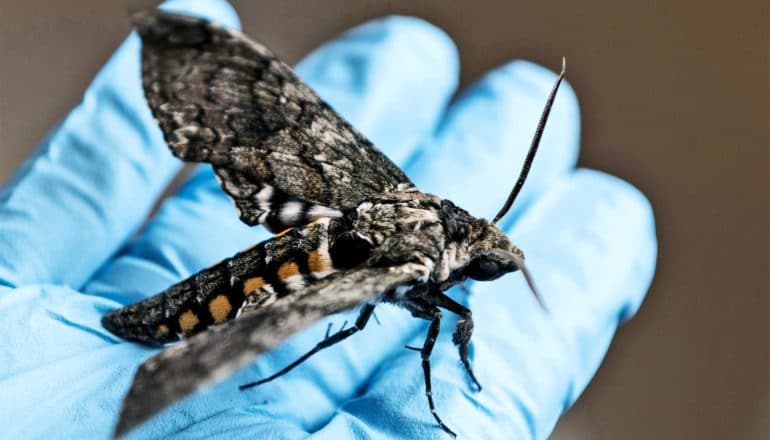
To extract nectar from flowers dancing in the wind, moths depend on precise, millisecond timing between their brain and muscles, researchers report.
Researchers captured and analyzed nearly all of the brain signals sent to the wing muscles of hawk moths (Manduca sexta), which feed on such nectar, to show that precise timing within rapid sequences of neural signal spikes is essential to controlling the flight muscles necessary for the moths to eat.
The research shows that millisecond changes in timing of the action potential spikes, rather than the number or amplitude of the spikes, conveys the majority of information the moths use to coordinate the five muscles in each of their wings.

Researchers have known about the importance of precise spike timing for certain specific muscles in vertebrates, but the new work shows the general nature of the connection.
“We were able to record simultaneously nearly every signal the moth’s brain uses to control its wings, which gives us an unprecedented and complete window into how the brain is conducting these agile and graceful maneuvers,” says Simon Sponberg, professor in the School of Physics at Georgia Institute of Technology.
“These muscles are coordinated by subtle shifts in the timing at the millisecond scale rather than by just turning a knob to create more activity. It’s a more subtle story than we might have expected, and there are hints that this may apply more generally.”
Moths with tiny wires
The researchers set out to study how the brain coordinates agile activities such as running or flying that require compensating for perturbations in the air or variations on the ground. While the size of the signals could account for gross control of the behavior, the fine points of choreographing the tasks had to come from elsewhere, they reasoned.
Recording motor control signals in humans and other vertebrates would be a daunting task because they use so many neurons to control so many muscles in even simple behaviors.
Fortunately, the researchers knew about the hawk moth, in which a single or very few motor neurons control flight muscles. That allowed the researchers to study neural signals by measuring the activity of the corresponding muscles, using tiny wires inserted through the insect’s exoskeleton.
Researchers Joy Putney and Rachel Conn determined the location of each wing muscle inside the moth exoskeleton, and learned where to create tiny holes for the wires—two for each muscle—that capture the signals. After inserting the wires in the anesthetized moths, the graduate students closed the holes with superglue to hold the wires in place. Connections to a computer system allowed recording and analysis.
“The first time I did the surgery by myself, it took six hours,” Putney says. “Now I can do it in under an hour.”
While connected to the computer, the moths flew on a tether as they viewed a moving 3D-printed plastic flower. To measure the torque forces the moths created as they attempted to track the flower, the researchers suspended the wired-up moths from an accelerometer.
Researchers then correlated the torque information with the spiking signals recorded from each wing muscle.
Importance of moths’ precision timing
The importance of the work relates to the completeness of the signal measurement, which brought out the importance of the timing codes to what the moth was doing, Putney says.
“People have recorded lots of muscles together before, but what we have shown is that all of these muscles are using timing codes,” she says. “The way they are using these codes is consistent, regardless of the size of the muscle and how it is attached to the body.”
Indeed, researchers have seen hints about the importance of precision timing in higher animals, and Sponberg believes the hawk moth research should encourage more study into the role of timing. The importance and prevalence of timing across the moth’s motor program also raises questions about how nervous systems in general create precise and coordinated motor commands.
“We think this raises a question that can’t be ignored any longer—whether or not this timing could be the real way that the brain is orchestrating movement,” Sponberg says. “When we look at specific signals in vertebrates, even up to humans, there are hints that this timing could be there.”
The study could also lead to new research on how the brain produces the agile motor control needed for agile movement, Sponberg says.
“Now that we know that the motor control is really precise, we can start trying to understand how the brain integrates precise sensory information to do motor control. We want to really understand not only how the brain sets up signals, but also how the biophysics of muscles enables the precise timing that the brain uses.”
The study appears in PNAS. The National Science Foundation and a Klingenstein-Simons Fellowship Award in the Neurosciences supported the work.
Source: Georgia Tech
The post To grab nectar, moths rely on split-second timing appeared first on Futurity.
from Futurity https://ift.tt/2ZDRMSs
No comments:
Post a Comment